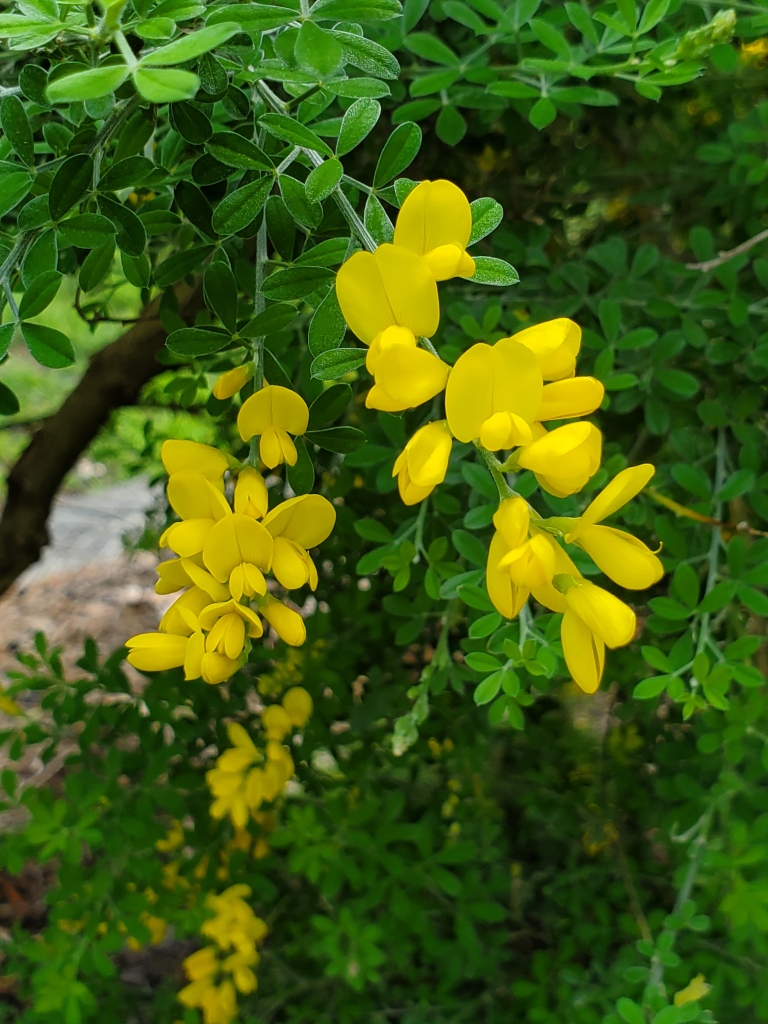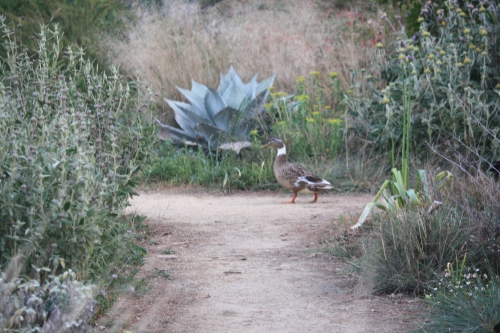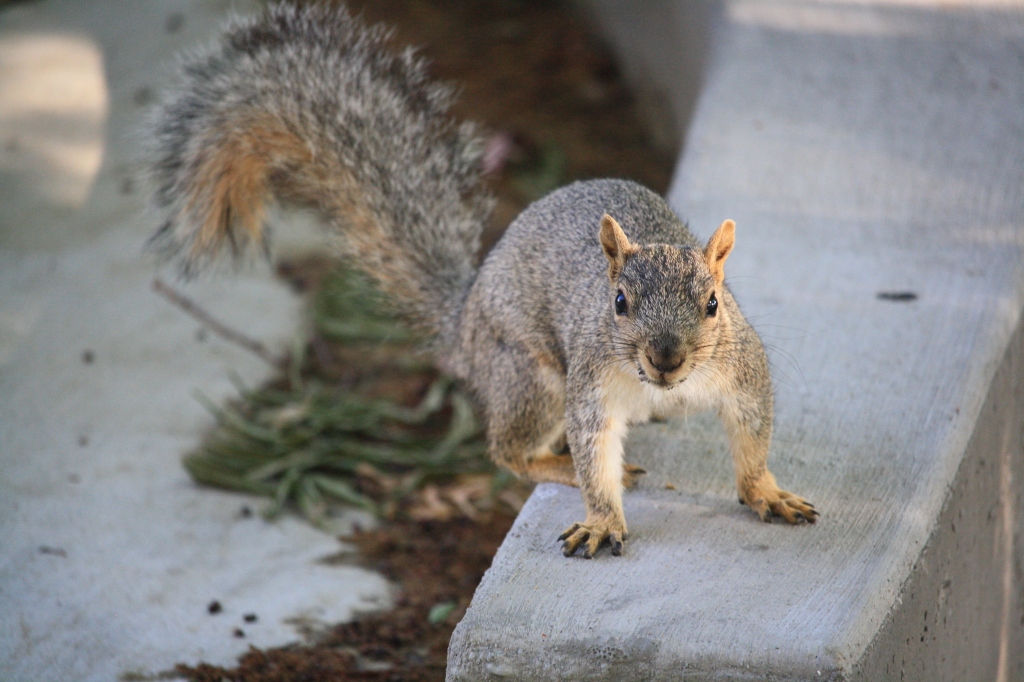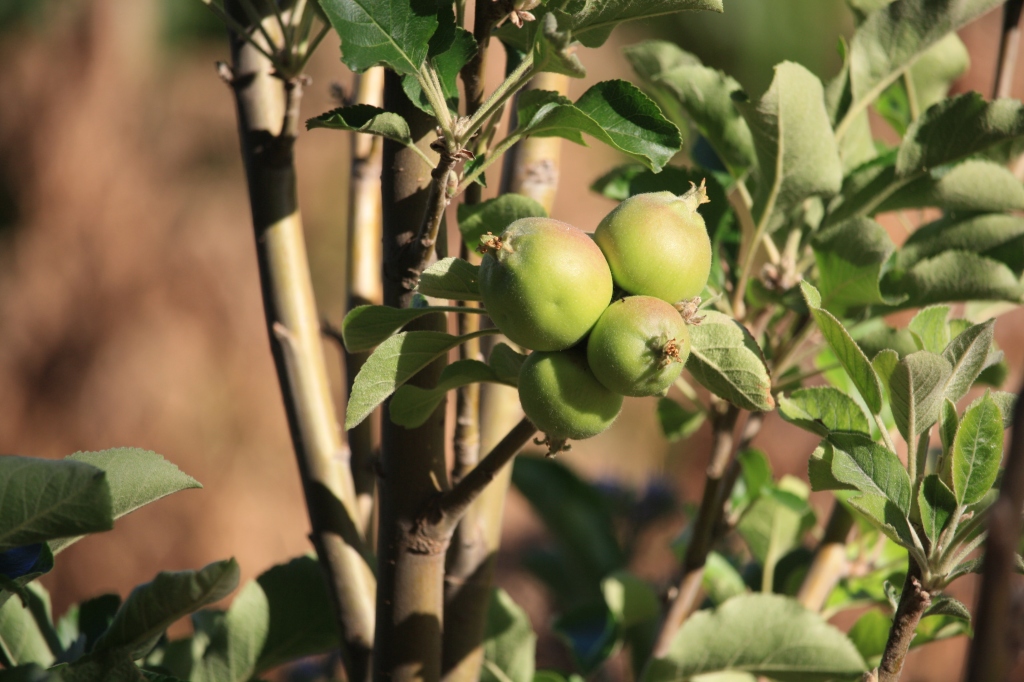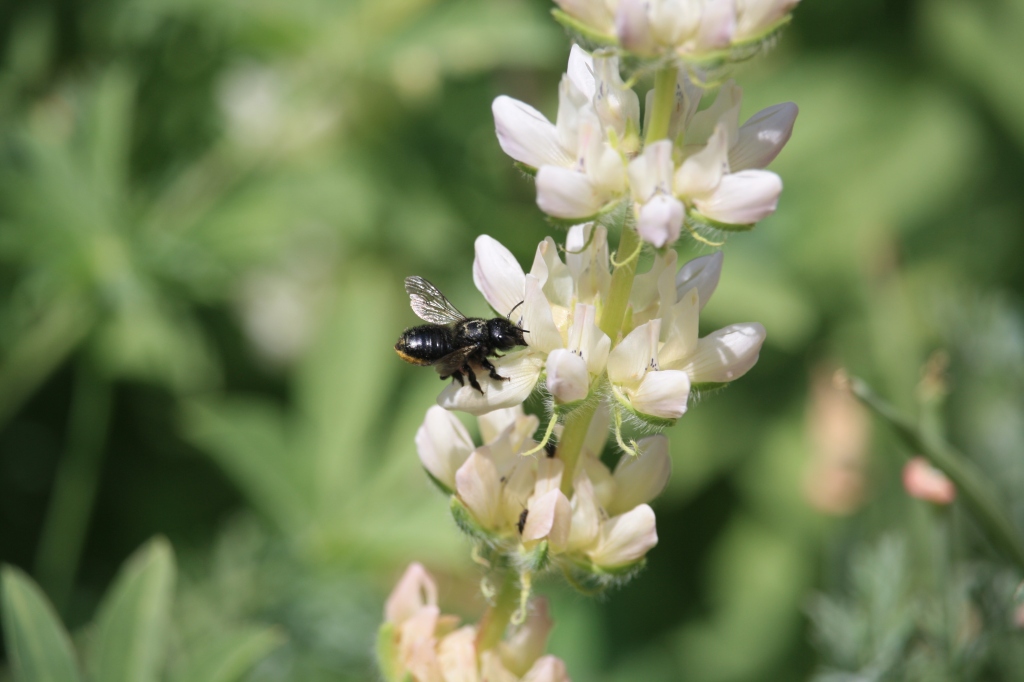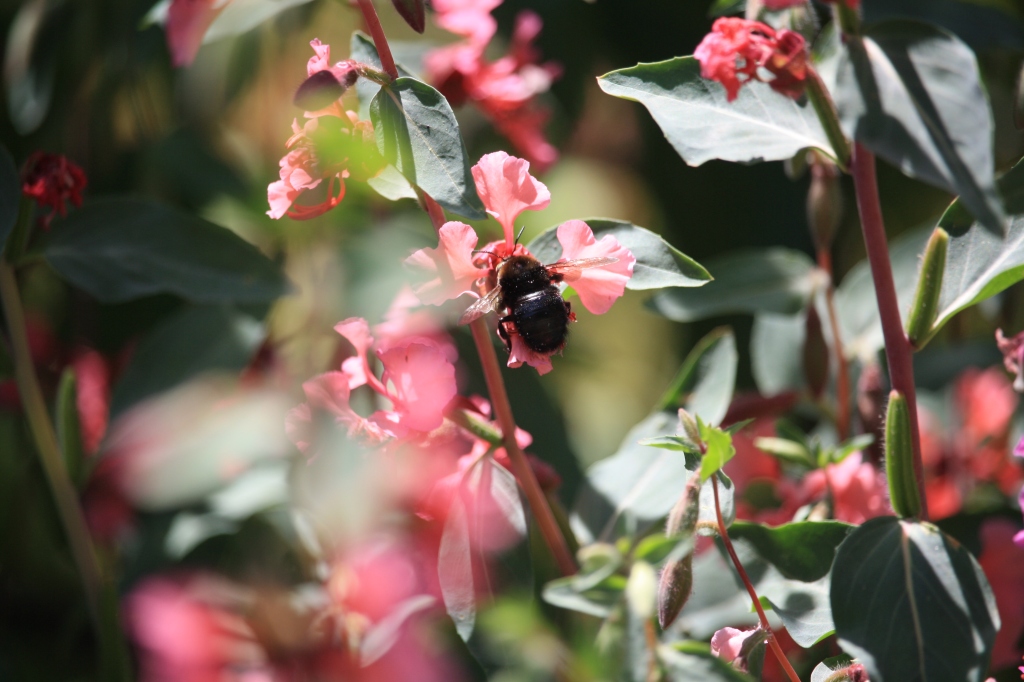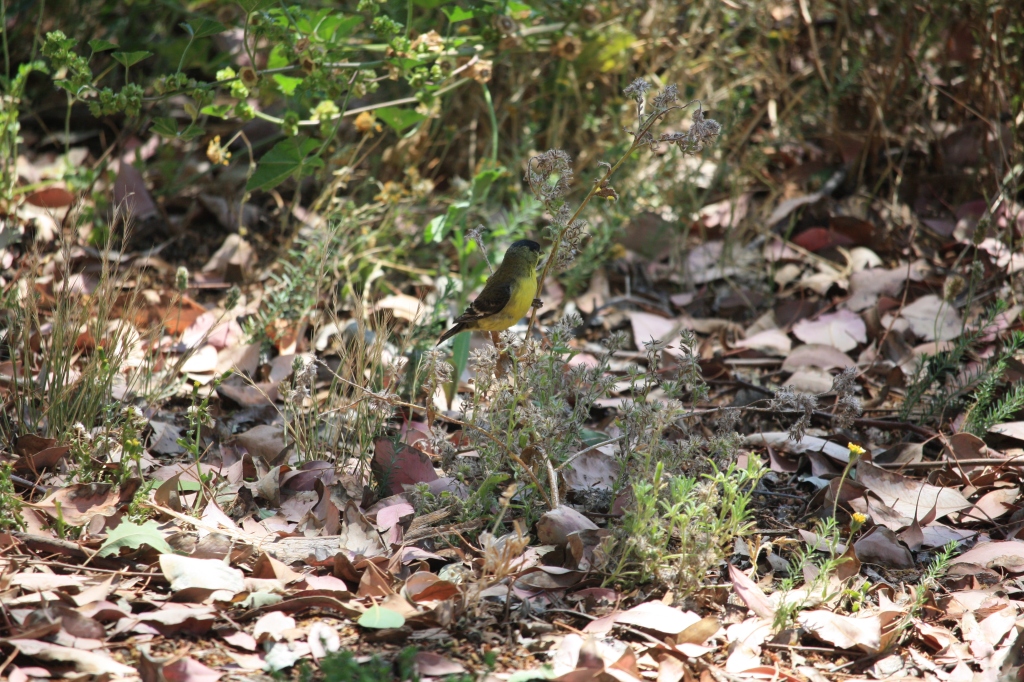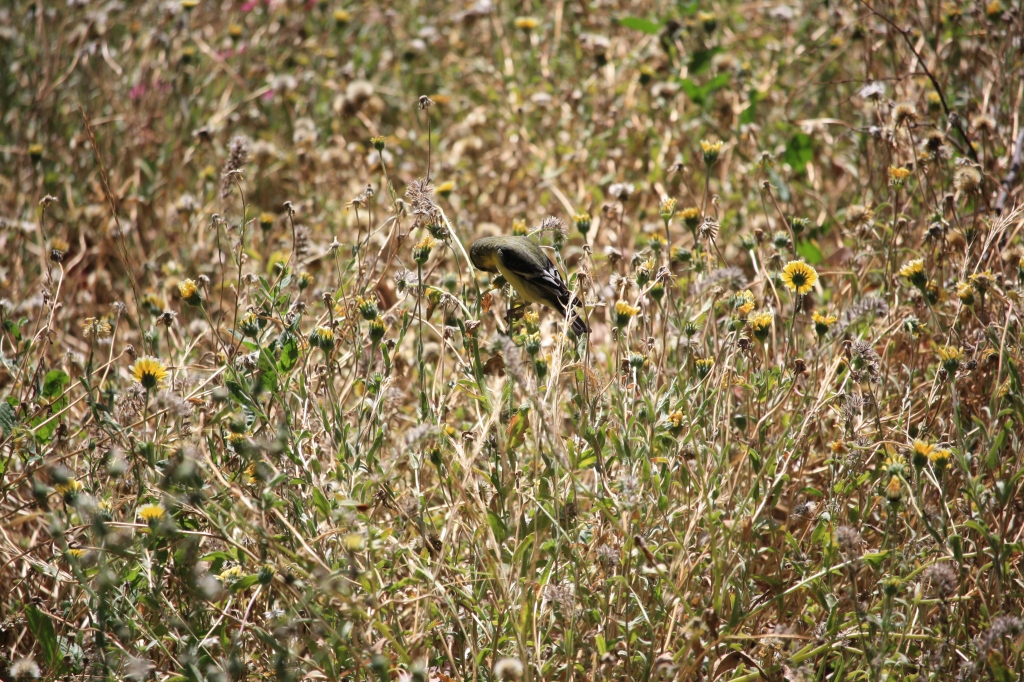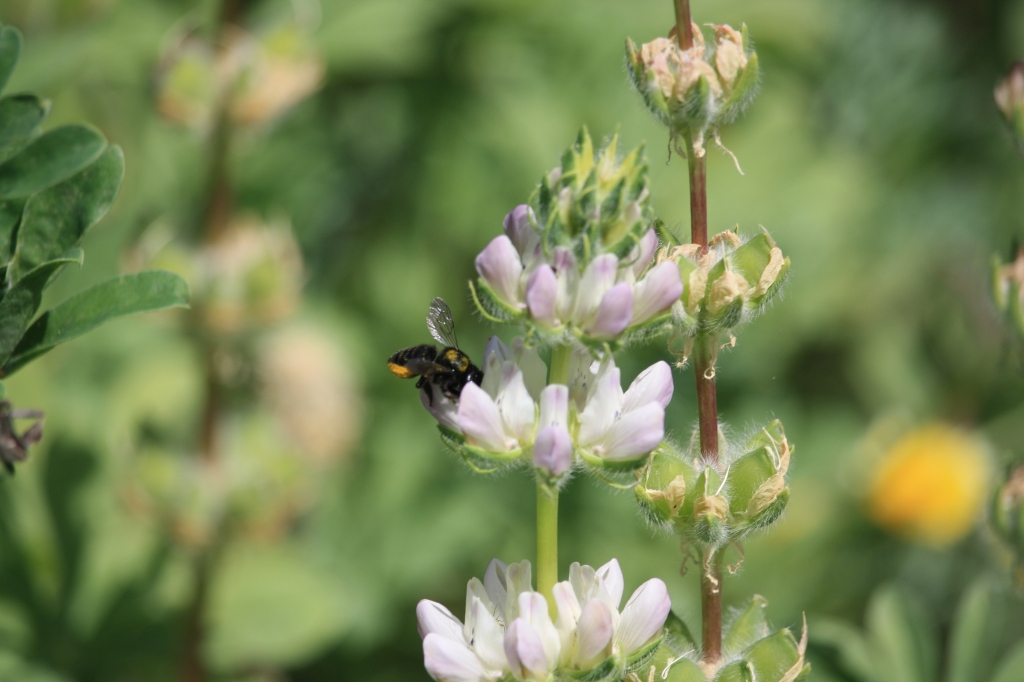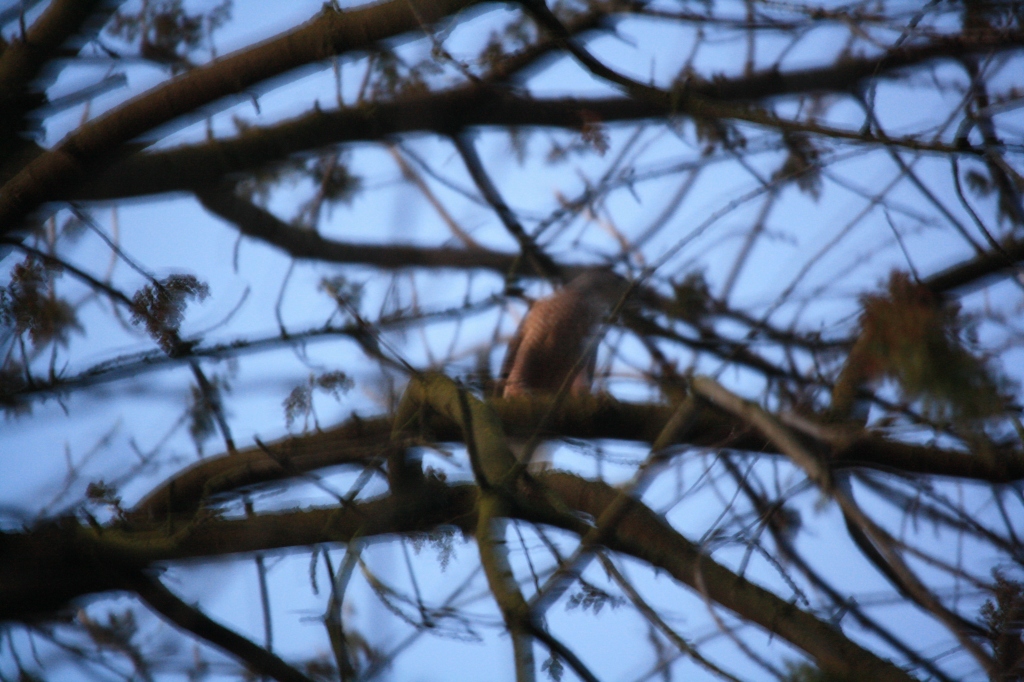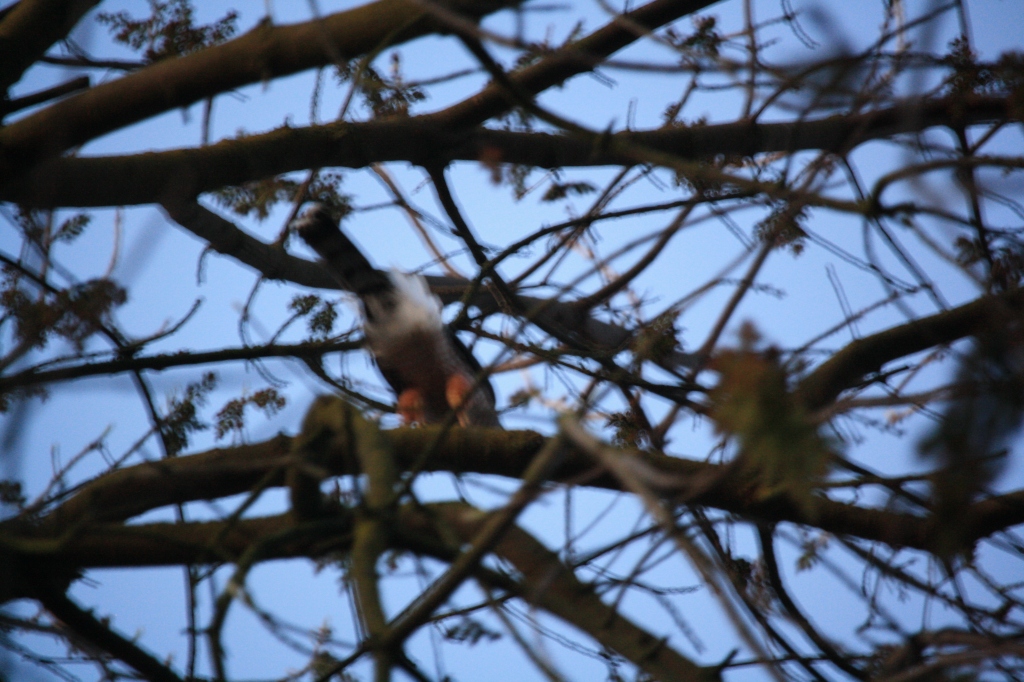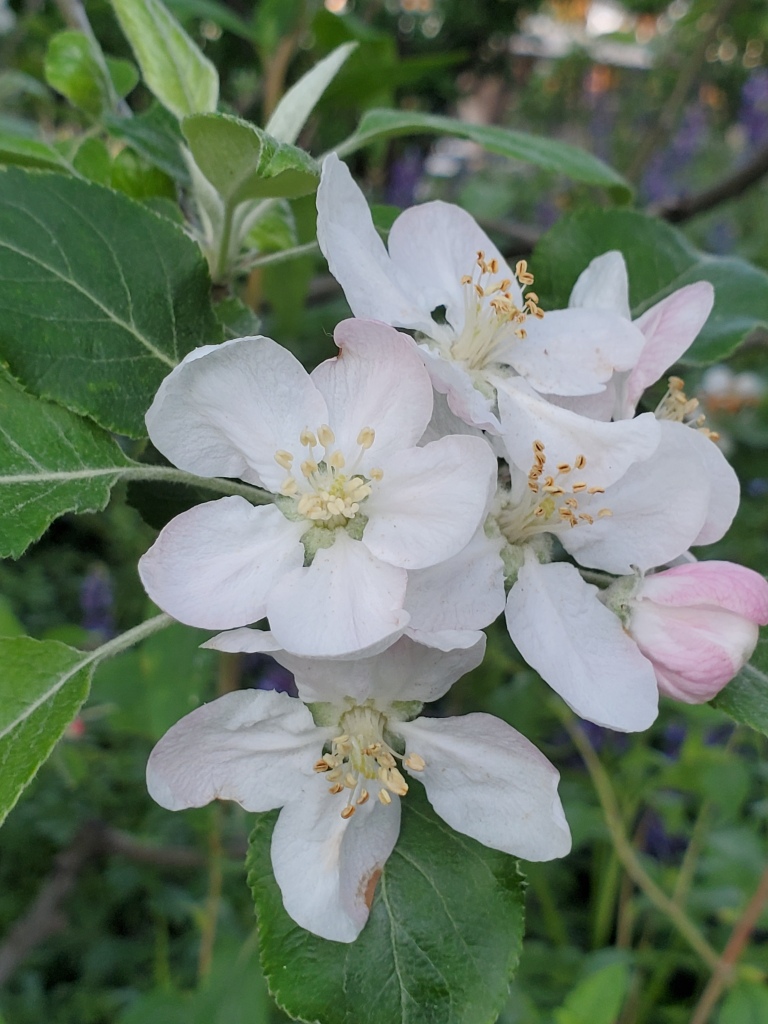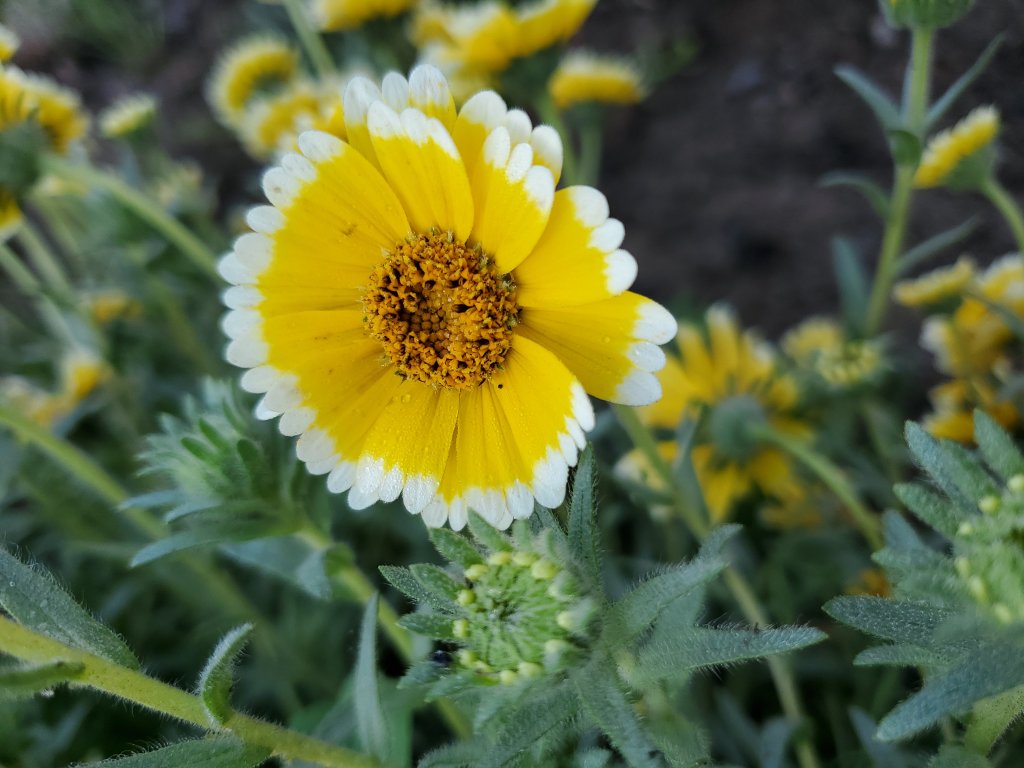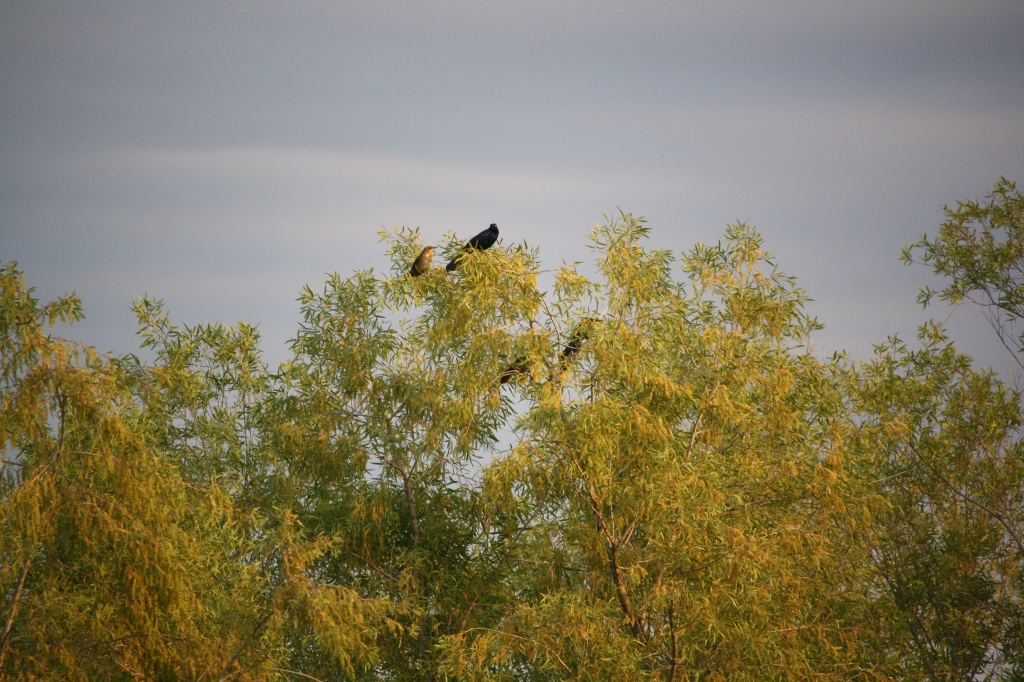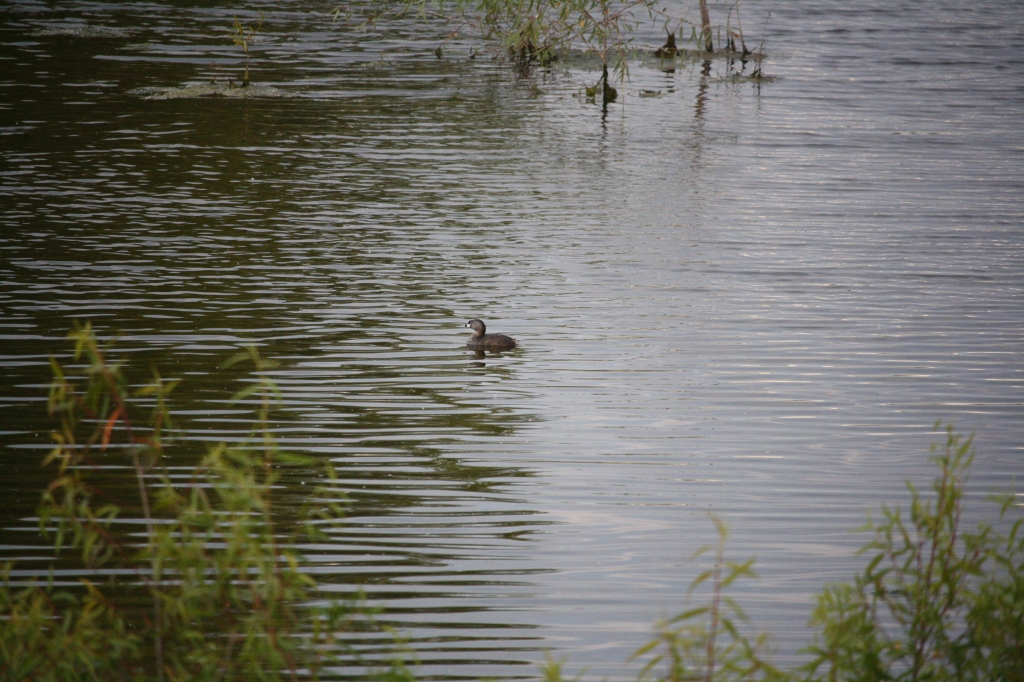Field Blog
Mid-Day at the Woodland Cemetery
This week, my Wild Davis students are revisiting their sit spots for a mid-day observation. My goal with these assignments is two fold: first, I want students to get to know a particular location; to see how the same space may be different at different times of day, what animals (including humans) are active at different times, which plants are flowering throughout the quarter, etc. Second, I know that students have few opportunities to slow down and relax; these assignments force them to sit quietly and just watch for 45 straight minutes. Students often note in their observation journals that these activities help them de-stress, to feel rejuvenated and calmer.
The first goal is obvious to the students and directly aligns with the course content and learning objectives. The second is more subtle, and relates to slow-looking, which is a theme throughout the quarter, but not a formal learning objective. This goal is much more easily impacted by societal factors, and harder for me to control. When I taught Wild Davis in Spring 2020, parks were closed and people attempting to spend time in nature were at risk of being arrested and fined. Everyone was scared – of the virus, of each other, of the police. Most of the students did their observations from the only place they were sure was safe – their own backyard.
Fast forward to 2023 and a rash of violent attacks rocks the Davis and UCD communities. Everyone is scared. I feel like since the pandemic, every crisis evokes a deep terror. We thought COVID would last a few weeks, a couple months and we were so wrong that every uncertainty now feels overwhelming. We wonder: how bad will this one get?
My students mid-day observations are due tomorrow, a suspect has been charged in the attacks, and no more have occurred since his arrest. Even so, I relaxed the rules around the mid-day assignment – students can choose a new location if their original spot feels unsafe (fortunately, no students had chosen the parks in which the attacks occurred) and students can do their observation with a friend. Week 9 is supposed to include a dusk observation, which I’ll make optional and provide an alternate observation activity. Even with a suspect in custody, our trust in public spaces and the people in them will take time to recover.


I am mulling over all these thoughts as I do my own mid-day observation at Woodland Cemetery. This time I walk there from my house a mile and a half from the cemetery. Cross Street is the most direct route, but I take Pendegast instead as there are some beautiful gardens on Pendegast, and a couple Little Free Libraries.
When I arrive at the cemetery, there are several cars and three groups of people visiting graves. Two are whole families, with lawn chairs set up for the adults, children playing among the headstones, music playing, and picnics laid out. I’ve only ever ‘visited’ someone’s grave during the funeral, when the grief is fresh and the mood somber. This levity, this celebratory air, seems like such a joyful way to honor a loved one. I wonder who they are visiting, if the young children are old enough to have known them, if they talk to the deceased or tell the children stories about them, if they’re visiting on an important date, or if they come regularly. This relationship with a loved-one’s resting place is not one I have ever known, so I have no frame of reference for what is normal. The third visitor is more what I imagine graveside visits to be like. It is a man alone, a little older than me, sitting quietly in a lawn chair. He leans forward in the chair, almost as though he is looking down at the grave, and reads something on his phone. He is there before I arrive and remains after I leave over an hour later, not once moving.
I spend most of the observation time documenting cemetery wildlife on iNaturalist. The cemeteries didn’t have many observations when I chose the location, so I’m hoping to expand the representation of wildlife in the park. I made the two cemeteries (Woodland and the smaller adjacent St. Joseph’s) a searchable ‘place’ on iNaturalist. I currently hold 87.9% of the observations in the cemetery, but who’s counting?!
The majority of plants in the cemeteries are not blooming. Many of the trees are conifers, and the grass is mowed frequently enough to not reach flowering. The majority of flowers in the cemeteries are fake and adorning headstones. The day is not ideal for pollinators, it is a tad too overcast and chilly; however, I wonder if the lack of pollinators I see is also driven by the graveside decorations. Do pollinators learn that most of the bright colors in this space are not truly flowers? I make a note to look into which pollinators are driven more by sight than by scent of the flowers. A scent-driven pollinator would not be fooled by a (scent-less) fake flower, but a sight-driven one might. The flowers I do find are primarily rosebushes, with a few creeping lantanas, and a lovely patch of purple-flowered pale dewplant covering one full grave. It is lovely, and should I ever end up in a cemetery (unlikely, given that I will be donating my body to science) I would enjoy this sort of blanket for my grave.

While I mostly focus on the plants in bloom, I make a special point to document the location of every ginkgo tree. As the students know, I consider Ginkgo biloba to be the loneliest species on Earth. First, it is the sole species left in its entire phylum (which is four taxonomic levels higher than genus, the equivalent of having only one species of flowering plant or one species of vertebrate) as all its closest relatives have gone extinct. Second, even the two sexes are often isolated. Given the unpleasant odor of the female cones, most ornamental trees that you find (such as in this cemetery) are males. The species is also, however, as a common herbal supplement. When ginkgos are grown as a crop, orchards are planted mostly of females (since it is the seeds, as well as leaves that are processed) and only enough males are planted to pollinate the many female trees. Consequently, I view ginkgos as lonely both taxonomically and socially, so I am pleased to find these three individuals planted in close proximity. I hope they are friends.
I’m also here to document animal life, though I see less than I anticipated. A few honeybees on the roses, a few squirrels napping on headstones (which I find very adorable), and a smattering of birds. The most interesting of these is European Starlings, which have nested in the palm trees lining the main road. I only recently learned that starlings nest in holes in trees, when I saw several along the banks of Putah Creek during the City Nature Challenge. I manage a lovely shot of one in its palm tree nest.
I also catch a strange interaction between two hummingbirds, which at first I think is mating, but when none of the necessary body parts appear to come into contact, I decide might just be fighting? I’m still unsure, and will post it to iNat hoping someone with more hummingbird behavior knowledge than I have comments on it.
Thinking Ahead
I still hope to see more wildlife on my dusk visit, though the relative lack of animal diversity has me a bit disappointed on this trip. I didn’t explicitly look for insects other than pollinators and aphids, so perhaps a more thorough survey is warranted on that visit. I also plan to do a more thorough survey of the trees, since this week I focused mostly on the blooming herbaceous plants. I also wonder what visitors, if any, I will see at the end of the day.
Dawn at the Woodland Cemetery
Once again, it is Spring Quarter at UC Davis, which means my EVE 16: Wild Davis students will be choosing their sit spots, in which they will complete three 45-minute observation activities throughout the quarter; one at dawn, one at mid-day and one at dusk. To start them off, I also do a dawn observation at a local green space – in the past, I have visited, the Wildhorse Ag Buffer, the East Regional Pond, the UC Davis BOG, the Ruth Risdon Storer Garden, and my own backyard. This year, I’m visiting the Woodland Cemetery.
Why a cemetery?
I first visited the Woodland Cemetery last summer with my sister, Tai, a historian at Johnson County Community College in Kansas. In her field, cemeteries long served as the primary resource for data on local population statistics like life span and family size. In her courses, students visit a local cemetery for an activity on documenting birth and death dates to determine average life span of men and women throughout different time periods.
In my field, cemeteries serve as increasingly important green spaces in urban centers. As more and more people live in urban or suburban areas, urban sprawl threatens even parks and other natural spaces. The sacrosanct nature of cemeteries protects them from alteration or development more so than a park or playground. Consequently, cemeteries are increasingly viewed as recreational spaces, important habitat for urban birds and mammals, and even tourist attractions. While these roles may be surprising and perhaps disconcerting, they also serve as avenues for continuing the investment of funding and other resources in order to maintain cemeteries indefinitely.
More personally, I also find cemeteries to be very calming spaces as they are intentionally designed for quiet introspection. I find the feeling of being alone and yet surrounded by people to be a curious one. Cemeteries hold a very personal history, and at first, it felt like a strange breach of privacy to visit the graves of people I never knew. Yet somehow I don’t think they would mind. Woodland is the county seat, so I assume the cemetery is one of the oldest in Yolo County, and I imagine the residents of 1850s Woodland (from which many of the gravestones originate) would be pleased to know their resting places are still visited over 150 years later.
Visiting the Woodland Cemetery
For my dawn visits, I prefer to be on site when the sun rises; however, the Woodland Cemetery doesn’t open until 7 am (approximately 20 minutes after the sun’s actual rise). I split the middle and arrive at the cemetery at 6:50. I assume I will be the only person on site; in fact, I assume the gates won’t actually be opened right at 7, so I am prepared to do most of my observation from the gates surrounding the park. I am wrong – when I arrive the gates are already open and a car drives through them just ahead of me. In the 45 minutes I spend in the cemetery, I see two cars come through, though neither stays long, and I see a handful of grounds crew members cleaning up debris and marking out plots.
The primary wildlife out at this time of day is the dawn chorus of birds. I hear more than I see – my entire visit is a pleasant cacophony of chirps, whistles, and songs, punctuated by the occasional whistle of a passing train. I recognize (by eye or by ear) chickadees, scrub jays, mourning doves (which seem especially apropos in a cemetery), blackbirds, hummingbirds, and even, to my great delight, a great-horned owl that swoops into a large conifer just at the end of my visit. I assume the owl is returning to roost after a night of foraging and the manner in which it cleans its talons after it lands suggest a successful hunt.

Beyond the birds, I see no other animals, though I have previously seen many squirrels in this space, and a few holes in the ground suggest some burrowing mammals as well, which I hope to see on my afternoon visit. I also hope to see pollinators in the future visits. Dawn is a bit early for even the busiest of bees, and the number of flowering plants in the cemetery make me hopeful for a robust pollinator survey in the afternoon visit.
I’m visiting the day after Easter, and I wonder if Easter is a popular day to visit the deceased. Even when I was religious, I was several states away from any family graves, so visiting grave sites was never something my family did, on holidays or otherwise. Not surprisingly, the older sections of the cemetery are not very adorned; however, graves in the newer portions, especially the newer section of St. Joseph’s, are bright with fresh flowers and gifts. It makes sense, given Easter’s relevance to death and mourning. It also lends this section of the cemetery a festive, almost celebratory air. I enjoy this evidence of loved-one’s visits – it feels hopeful somehow, especially with Easter’s ending in resurrection.
As I wander, I notice a rolling canopy (often used for sun and rain protection during graveside services) placed over a freshly covered grave. It doesn’t yet have a headstone, instead a collection of flower bouquets cover the freshly turned dirt from head to toe. One arrangement contains multiple plastic sport fish and a pair of antlers – a fisher and hunter, then. I enjoy that even this temporary memorial tells me something about the person below.
Thinking Ahead
One of my goals for the visits this quarter is to document the cemetery wildlife on iNaturalist. Not surprisingly, both the Woodland Cemetery, and the smaller adjacent St. Joseph’s Cemetery, have very few iNaturalist posts, as most visitors to the cemetery are likely not focused on urban wildlife. Currently, the Woodland and St. Josephs cemeteries have 9 observations:a daffodil, a buttercup, a garden snail, a grimmia moss, two western bluebirds, a pocket gopher, and the tail feather of a feral pigeon courtesy of yours truly on my visit with my sister. The iNaturalist project Found Feathers is my absolute favorite, so a significant number of my iNat posts are feathers. And already one of my assumptions is incorrect – two of the posts (the buttercup and the moss) include a measuring tape for scale, which suggests not a casual iNat post by a graveside visitor, though the most recent post (other than mine) is from 2021. For my afternoon and evening visits, I hope to learn more about both the wildlife and the human residents. I can’t seem to find online a year that that cemetery was established, so on my afternoon visit, I plan to do a casual survey of the dates of internment to see if I can narrow it down.

Dawn in an urban lawn
It’s spring quarter again, meaning the 2022 cohort of Wild Davis students are starting their timed observations! Students are asked to visit the same urban location (colloquially called a ‘sit spot’) three times throughout the quarter (dawn, mid-day, and dusk) and observe the location for 45 minutes. In past years, my sit spots have included urban natural spaces such as the Wildhorse Agricultural Buffer, the Woodland Regional Park Preserve, and the Ruth Risdon Storer Garden in the UC Davis Arboretum. This year, I’ve chosen the backyard of my new home, as a chance to get to know the wildlife in my neighborhood a little better.

This week’s observations are to occur at dawn, so I arrive in my backyard about 6:10 am. It is chilly, my phone says 54 degrees F and I can just see my breath, so I’ve brought some hot coffee and a blanket. It is still rather dark, though bright enough on the horizon that stars are no longer visible. Despite it not being quite dawn, the mockingbird in my north neighbor’s tree is already awake and calling. I already like this mockingbird a lot as it does a beautiful imitation of a frog that I very much enjoy. My west neighbor feels rather differently – last week when I ate dinner on the patio, the bird was particularly vocal and he came running out of his house waving his hat to scare it off. In classic mockingbird idgaf fashion, it moved only to the north neighbor’s tree and kept screaming.
As dawn progresses, I hear other birds, though none within my yard. Some crows caw and fly over, and a few songbirds join the dawn chorus from throughout the neighborhood. One I recognize as a black capped chickadee, though I have not seen them in my yard yet. In fact, the only birds I’ve seen in my yard are the mockingbird and a scrub jay. I’ve hung two feeders up, and plan to pick up a birdbath soon, in attempt to attract more, though these have not yet been successful.


The remnants of a bird I found in the yard when I moved in suggest the neighborhood cats may be to blame. I have seen two different cats traipse through my yard (despite it being completely surrounded by privacy fence) and I know how effective cats can be at hunting urban wildlife. I will be sorely disappointed if I cannot attract some birds to my new yard. Perhaps they just need some more time to discover the feeders.

As I lament the lack of birds, my mockingbird is joined by another. After several minutes of raucous flights around the north neighbor’s tree, they finally alight on my fence to the east, one cawing angrily at the other. The specifics become clear when they mate on the fence, after which the female (my frog-caller) runs off the male and retreats to the tree. An oblivious scrub jay who lands in the tree a moment later gets the same treatment. I can’t help but chuckle – she is *not* having it today.
My yard is overgrown, and probably needs to be mowed, but I enjoy the feral look. It is an unplanned mix of legit lawn grass, wild barley, and common mallow, which attracts a pleasant variety of insects. I especially like the lady bug I find sleeping in the mallow. Last week, I saw a butterfly alight momentarily on a mallow and wondered if she had lain an egg. Once, I managed to photograph a painted lady laying an egg and they seem to choose curiously dangerous locations. When I look it up after my observation, it seems that various species of mallow are nursery plants for many butterflies. All the more reason to not mow (as if I need another).




In addition to the birds, I wonder at the lack of squirrels. I haven’t seen a single squirrel in Woodland since I moved here. I look them up on iNaturalist and there are less than a dozen squirrel observations in all of Woodland, and none near my neighborhood. Seems odd.
My favorite part of my yard is the volunteer oak tree that has popped up in the northeast corner. I’ve named him Yuukis (pronounced YOU-kees), which is the Mutsun word for “oak”. Mutsun is one of the eight language groups of the Ohlone people, native to the northern coast regions of California. Already, in only the a couple weeks, Yuukis has noticeably grown. I’ve surrounded him with a small chicken wire enclosure to protect him from being trampled or eaten, and I will keep a close eye on him this summer to make sure he survives his first dry season.
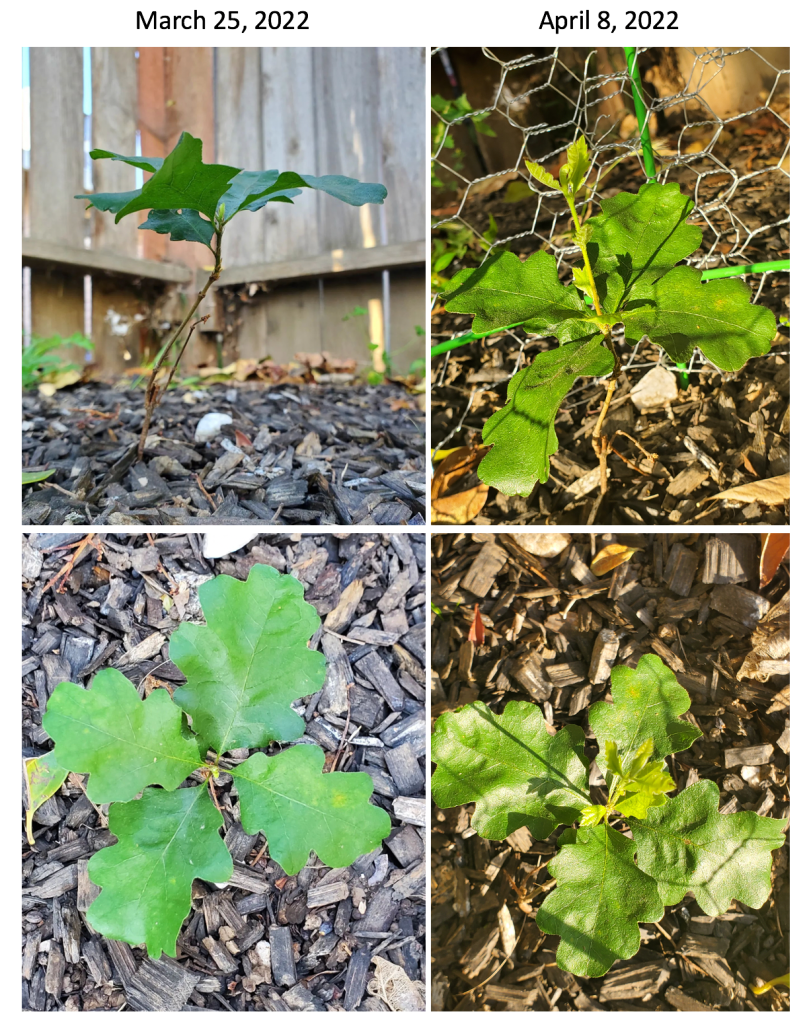
As my observation window ends, the neighborhood begins to wake up around me. I hear one neighbor hosing down their backyard, and another’s dog begins to woof softly. The trains pick up as well, and I hear several whistles echoing from the nearby tracks. My last task is to collect photos of three green organisms, to post to iNaturalist for the CNC Sacramento twitter challenge. I choose three plants from my backyard that I have not yet posted iNat: the wild grape along my eastern fence, the orange tree along the western fence, and a stalk of barley from the middle yard. I will upload Yuukis and the insects as well, I especially look forward to tracking Yuukis’ growth throughout the coming years.
This week in class, the students will turn in their observation journals, when I will get to learn what locations they chose and how their morning observations went. I look forward to reading their thoughts and reflections and getting a sense for the sit spots they visited.
Dawn at Dr. Ruth Risdon Storer Garden
It’s spring quarter again, which means we’re back in the Wild Davis saddle and starting our urban ecology field observations! As always, the quarter includes the students choosing a location to do 45-minute observations throughout the quarter at different times of day. Often, the students in the class haven’t done this sort of activity before (just sit and experience a place for a long time) and so as an example, and just because I find it relaxing, I do them as well.
In past years, I’ve chosen natural spaces near my house – the Wildhorse Ag Buffer in northeast Davis, the East Regional Pond along Road 102 between Davis and Woodland, and the Biological Orchard and Garden on the UC Davis campus. This year, I’ve chosen the Dr. Ruth Risdon Storer Garden in the UC Davis Arboretum and Public Garden.
I’ve chosen the Dr. Ruth Risdon Storer Garden because Ruth herself has been on my mind a lot lately. She was the first female physician on the UC Davis campus and the first female pediatrician in Yolo County. She was also an avid gardener and dedicated member of the Friends of the UCD Arboretum. The building that I work in (Storer Hall) is named after her husband, Dr. Tracy Storer, a well-known zoologist/ecologist and professor at UCD for over 30 years.
The reason Ruth has been on my mind is that she is part of a revamping of the Storer Hall Lobby that, while somewhat derailed by the COVID pandemic, has been in the works for a while now. In response to feedback from undergraduates in the EEB major at UCD, published research on how public spaces impact students sense of belonging, and faculty interest in more visibly representing diversity, the faculty in my department are planning some changes to the signage and portraiture in the Storer Hall Lobby. Currently, a large portrait of Tracy hangs prominently in the entranceway over the main staircase, along with a small biography plaque. We hope to add similar imagery and a biography of Ruth to this space (either by adding an individual portrait of her, or replacing the one of Tracy with one of the couple together). While the garden is a beautiful dedication, and aligned with Ruth’s own love of gardening and the Arboretum, I have found that few students (and faculty!) are aware the garden exists, or knowledgeable on Ruth’s legacy. Indeed, the faculty member with whom I am working on the Lobby updates has been a professor here for 10 years and didn’t know the garden existed. Consequently, we think including her in portraiture in the Storer Hall Lobby will both increase visibility (literally and figuratively) and knowledge of her contributions to UCD and Davis, and bring attention to the garden as her dedicated space.
Since that process is moving rather slowly given (waves hands at the world), I’ve decided to use this small platform as a way to at least bring Ruth’s accomplishments and her garden to the attention of my students. Our first observation occurs at dawn, so I made my way out to the Ruth’s garden at 6:45 Tuesday morning (Apr 6).
The first thing I notice when I park on the road next to the garden is the redbud tree blooming inside. I love redbud trees, with their quirky shape (you absolutely cannot prune a redbud, you have to just let it be the shape it will be), and their unabashed blooming when everything else is still green or brown. I identify a lot with redbuds, to the point that I frequently use the screenname Cercis, the name of the redbud genus.

The garden is clearly meant for just such observational experiences – there are many benches spread throughout the garden, along its winding and interconnected paths. Each of the benches bears a dedication; the bench I’ve chosen today is dedicated to Allie Greene by her husband. The benches and their dedications lend a quiet sense of community to the space, a feeling that you aren’t completely alone in the garden, or at least not alone in enjoying it. Allie’s bench sits beneath a crabapple and a cenizo tree, both of which are in the early stages of budding out.
Perhaps my favorite dedication in the garden is the plaque honoring Ruth’s friendship with Mary McGraw Miller. The garden has many varieties of roses, which apparently were a favorite of both Ruth and Mary, and I very much love the special honoring of long-time female friendships.

Friends and neighbors more than 50 years, they shared a friendship that bloomed along with their roses, creating beauty for all to enjoy.
In Loving Memory
Mary McGraw Miller, June 1 1911 – February 18, 1993
Ruth Risdon Storer, February 25, 1888 – September 13, 1986
The roses indeed are beautiful, particularly so in the early morning dew. I imagine they will smell quite lovely on my midday observation when they are warmed in the afternoon sun.
As I settle on the bench with my coffee, I quickly notice the noise; the garden is loud with both natural and anthropogenic sounds. The garden is near the road and even at this early time cars driving by are audible, as are distant trains. A grounds crew is also working in the Arboretum lawn nearby, and their leaf blowers distract from the natural peace of the garden. There are several bird species loudly calling to one another – I recognize the cawing crows and screaming scrub jays and the worn-out-squeek-toy call of an Anna’s hummingbird. There are several other twitters and chirps that I can’t identify by ear, though I recognize the birds themselves as white-crowned sparrows and (the most unfortunately named bird) bushtits. Later in the morning, I hear a single loud barking call and while I don’t recall ever having heard it before, I instantly think of a green heron. Later, when I check the Cornell lab and eBird recordings for green herons, I’m pretty sure, but not certain, that’s what I heard.
As I wander the gravel paths of the garden, I startle a trio of ducks; one male and two females. They quack at me and continue on their way, amusingly keeping to the paths just as I do. They are dabbled with white, indicating that they are offspring of hybridization between the wild mallards and the couple domestic white ducks that have taken up residence in the Arboretum. The origin of the domestic ducks is unclear, though the most likely mechanism is that they are former pets, released to the Arboretum by their disinterested owners. I also notice birds flying over the garden, including a hawk that is harried by three of the cawing crows, and two great egrets. All of them appear to be leaving the Arboretum waterway, flying northwest over the garden.
The garden itself contains quite a bit of signage. The majority of plants have ID cards posted at their base identifying their common and scientific names. Plants of note (called Arboretum All-Stars) also have larger signs outlining their range and environmental needs, interesting facts, etc. These sorts of signs are common throughout the Arboretum. In addition, Ruth’s garden also has signage with gardening tips and strategies – a testament to her knowledge of tending her own gardens. I chuckle at one titled “Am I high maintenance?” Having recently received my second COVID vaccine, I also am disease resistant and now consider myself a ‘low maintenance rose’.

Considering the sign, I check the roses in the garden closely for signs of disease, and as the sign suggests I find very little. I do see one leaf which appears to have a fungal infection, and a remarkably small number of rosebuds carry aphids. While the signage focused on fungal infections, I wonder if ‘low maintenance roses’ also harbor some protection against aphids. The photos below may appear to contain a lot of aphids, but compared to rosebushes I’ve seen elsewhere on campus, these are small aphid loads.
Just as I’m nearing the end of my observation, the sun begins to peek out of the trees to the east, blanketing the dewy lawn behind the garden in shafts of sunlight. It is a beautiful sight, and makes me pleased I chose this location for my observations, and pleased that it is dedicated to a woman I’ve recently learned more about and come to appreciate (even if I still think she deserves a portrait in Storer Hall as well).

Wild Davis 2020: Evening at the Campus BOG
Spring Quarter is almost over and last week, the Wild Davis students completed their last of their observations, this one to be done in the evening.

It’s still hot when I get to the BOG around 6 pm, so I choose a spot at a shady picnic table to take my notes. I startle both a bunny and a squirrel, possibly the same squirrel that was so bothered by my presence at the morning observation 🙂
The first thing I notice is that the wildflowers are nearly all finished blooming and beginning to set fruit. I pick a fruit off of a lupine and split it open in my hand. Lupines are members of the legume family (which includes peas and soybeans), all of whose fruits form a pod that splits open along two edges. The small orchard along the north eastern lobe is also setting fruit, as are the elegant clarkia that were blooming when I was last here.
The south eastern lobe that was full of flowers on my afternoon observation has been cleared, and I notice what looks like the beginning of clearing of the lupine field in the north eastern lobe. This answers my question about whether or not the BOG crew are still working on the site even with the lockdown, but it raises another question. I had assumed the annual flowers reseeded themselves, which is difficult to do if the fruiting plants are cleared out. Now I wonder if the eastern lobes are seeded every year.
The few flowers still in bloom have attracted some pollinators, though on the whole there is not a lot of insect life in the BOG this evening. Similarly, I only hear a couple of birds, including the goldfinches I have seen on my previous observations, though they keep the trees and out of my sight.
More noteworthy this evening than on my other observations is the human presence. Throughout the entire observation, I am distracted by the low hum of the air conditioning unit in the Mann Lab just south of the BOG. It runs continuously the entire 45 minutes and makes me wonder if all the campus buildings are being maintained at their normal temperatures. Seems like a waste of money and energy for empty buildings, though most of the buildings are probably not truly empty. My building for instance still has a skeleton crew of office staff to take deliveries, and researchers with living organisms still have to come in to keep them alive. Additionally, we are moving into Phase 2 soon, when some of the restrictions on people and activities in the labs will be relaxed.
I also see a number of groups of people walking and biking around campus; more people than I have seen here on my previous observations. They appear to be family groups for the most part, and we all easily keep our distance as they mostly pass by the BOG without coming into the center where the picnic benches are.
This quarter, I haven’t found these observations as relaxing as I normally do. Generally, I enjoy the quiet solitude and the chance to slow down and just look and listen for a while. This quarter, though, I have too much solitude and I am so much more scatterbrained that focusing just on looking and listening has been hard. I look forward to being around people again, whenever the uncertain future ever allows that. In the meantime, I’ll at least get to read this week what my students found on their observations.
Wild Davis 2020: The Campus BOG at Mid-Day
This week, my Wild Davis students and I are doing our mid-day observations. Earlier in the quarter, we observed a location at dawn, and in a few weeks, we’ll revisit the same spot at dusk. This quarter, I’m doing my observations at the campus BOG, which gives me an excuse to get out of my house for a little bit and is one of my favorite quiet nature spots on campus.

Yolo County’s health guidelines now include wearing facemasks in all public spaces. I’m not entirely sure if the BOG would be considered ‘public’ – I’ve noticed most people not wearing masks outdoors, but I err on the side of caution and wear one anyway. The mask I’m wearing is one my sister made for me, out of spare material from a quilt we made together over the summer. She has made masks for our whole family, as well as her husband’s family out of spare material from a variety of previous craft projects and they are more comfortable and ‘stylish’ (if perhaps less effective) than the medical masks. They are also made with love, which is what I enjoy most.

It doesn’t make much difference out here at the BOG today. When I arrive a few minutes after noon, there is only one other person in sight and she is sitting quietly at the benches with a notebook and headphones (and no mask). It is easy to keep well more than 6 feet apart and we mostly ignore each other throughout my observation.
When I was here in the morning a few weeks ago, most of the animal activity was morning birds. Dawn is a little too early for the pollinators, though I did see a couple bumble bees right at the end. Today, as I expected, the pollinators abound. As soon as I get close, I can see numerous dragonflies swarming above the flowers and hear the gentle hum of the honeybees.

It appears that peak bloom has passed for many of the species. Much of the Phacelia is closing up to set fruit, though the few flowers that are still open are popular, as always, with a wide variety of bees. The silver and arroyo lupines are also mostly gone, though the yellow coastal bush lupines still abound. As I walk through the center of the BOG, I can smell the plants even through the mask. The smell is more vegetative though, than floral – almost like a fresh-cut lawn.
The BOG appears very dry. I don’t know if that’s because many of the annual flowers are passing their prime and putting their last resources into fruit, or if the garden is not being watered or irrigated as much under the current shelter in place guidelines. I wonder how managed this garden is – I have seen people working in it frequently, yet it also appears that the annual flowers reseed themselves and the garden does not have a manicured or cultivated look, but is instead allowed to grow somewhat ‘wildly’.
Many organisms prefer a less ‘perfect’ garden, and indeed, in addition to the pollinators, I also see a variety of birds, and a bunny, and of course squirrels. One squirrel in particular seems personally offended by my presence at the picnic table and barks at me until I apologize and move to another.
At my new bench, I stop to make a short recording of the bird calls I hear. The voice recorder app I use shows the amplitude of the sounds its recording and as I watch it, I notice that it’s recognizing sounds even when the birds are silent. That’s when I notice there are construction noises, and the faint beep of a large vehicle backing up somewhere. I had blocked out these noises until the recording brought them to my attention.
I see several goldfinches, as I did on my morning observation. They flit about in a small group and are easily startled as I walk through the garden. They prefer the northwestern ‘lobe’ of the garden which is close to the Eucalyptus stand and they dash back and forth between the two, chattering at each other and picking seeds out of the BOG plants. I enjoy how they perch on tiny plants that don’t look sturdy enough to hold their weight. One in particular seems to struggle to balance on a blade-like leaf, which frankly looks kind of painful for her little feet.
As I’m hunting for good pollinator photos, I come across a bee I’ve never seen before. At first, it appears to have a bright orange line across its abdomen, but through my zoom lens I can see it is a neat row of pollen. I have never seen a bee carry pollen like this before and I’m unsure what type of bee it is. It’s about the size of a small bumble bee, but shiny and black like a carpenter bee. It is clearly neither of these, though, as its proportions are different than both. It is beautiful, and I capture a few good photos to use later to identify it.
Later that evening, as I’m going through the photos at home, I send one to Wild Davis TA and bee afficionado Chris Jadallah. He quickly identifies it as a member of the Megachile genus, which are known to carry pollen in this manner, and forwards the photo to another bee expert friend of his, who confirms it as Megachile gemula. I look this species up on iNat and find its common name is ‘small-handed leaf cutter bee’ which I find pretty amusing. I get suspicious though, when I notice that iNat only has records of this species in the northeastern quadrant of the US, the closest observation being in Illinois. There are only 18 total observations, though, so perhaps its full range hasn’t been documented. I ask Chris how sure his friend was and post the photos to iNat under genus Megachile, just to be safe.
For the rest of the observation, I sit quietly at the picnic bench and simply watch the garden. It is a beautiful day – a little warm in the sun, but perfect in the shade, and from this vantage point I can see the goldfinches darting back and forth as well as the dragonflies swarming over the southern ‘lobe’ of the garden and the occasional butterfly and hummingbird. I enjoy the chance to decompress for a moment; this quarter has been stressful in a variety of ways, for the students as well, and even a short break is a welcome one.
Wild Davis 2020: Morning Observations at Putah Creek (guest post by Chris Jadallah)
This post is part of a series on the Wild Davis 2020 California Naturalist training course. This post is written by Wild Davis Graduate Teaching Assistant Chris Jadallah.
I am excited to spend some time at the Putah Creek Riparian Reserve for EVE 16: Wild Davis this quarter. Somehow I only made it here for the first time a few weeks ago, and I have already returned a few times since. Riparian areas are very special. They support so much biodiversity, serve an important ecological function as habitat corridors, and offer so much cultural, aesthetic, and economic value to people throughout the world. The parking lot is a short drive from my home near the edge of West Davis, just off of County Road 98 Right as the dark morning sky is starting to fade away, I head over with coffee in hand.

I arrive at the particular spot I selected within the Reserve at around 6:40 AM, just as the soft light of the morning sun officially rises up above horizon. The tops of the trees are bathed in a golden glow, but because the sun is still low, everything below remains in a cool light. A number of different trees make up the riparian forest towering over me, including valley oak, eucalyptus, black walnut, willow, and even what I think is an almond tree based on the fuzzy green fruits covering its branches. Perhaps it is a volunteer from a nearby farm which wouldn’t be surprising given that Putah Creek cuts through a landscape matrix of primarily agricultural land. The trees are filled with young green leaves that slowly drift in the very gentle breeze. The sky is clear but the temperature is brisk, about 48 degrees according to my phone. It’s chilly even under my fleece jacket, but in a refreshing way that reminds me of first coming out of the tent after a night camping in the woods.

I find a spot in the middle of the creek’s floodplain, and sit on the edge of a small cliff facing the water directly to the south. The ground is cold but mostly dry, except for the areas covered in vegetation where it is visibly damp, either from the morning dew or the storms that passed through the Sacramento Valley last week.
Before I can even settle into my spot, I am interrupted by a loud splash near the opposite bank. I see a plume of sediment underneath the surface of the water and immediately start scanning the area, thinking I might be able to find a fish. I was here last weekend and saw a largemouth bass hanging out near some large woody debris before swimming away. Immediately, I see a three foot long, slender object torpedoing from the area where I saw the splash away from me upstream. It disappears into the cover of an overhanging tree within a few seconds. My eyebrows furrow in incredulity and I stare in shock, thinking to myself, “What in the world?! That fish is HUGE. Did I really just see a three-foot-long fish? I’m pretty sure bass don’t get that big, could it be a catfish?” All of a sudden, it hits me – it was a river otter! My jaw drops in awe and stays that way for a good five seconds. I’ve only seen a river otter once before, when one was living at the Sutro Baths in San Francisco many years ago.

I’ve previously heard of river otters living in the Davis area, namely in the pools and canals of the Yolo Bypass, but I was definitely not expecting to see one today. I spend a good five minutes starting intently at the overgrown area where it disappeared, hoping to catch another glimpse, but alas, there was no sign of it. I begin to doubt myself, wondering if it was really just a big fish, so I pull out my phone to check the iNaturalist app and see if there had been any other observations of otters in the area before this. Lo and behold, someone recorded one in the exact same location less than two months ago. Just a few minutes into my observation, and my day was made!
It takes me nearly fifteen minutes to get back to more general observations of the site and stop thinking exclusively about the otter. I re-focus, and spend some time paying attention to some of the geomorphological and hydrological properties of Putah Creek. The water is about five feet away in front of me and below me, my feet hanging over the exposed earthen bank. In the area directly in front of me the creek is clear and fast-flowing, ranging in depth from about six inches to two feet. Medium-sized, multi-colored gravel make up the creek bed. Periodically, a small piece of algae or a leaf quickly floats by. About twenty feet across the creek is a marshy island, from where I assume the otter was either resting or sleeping before I accidentally disturbed it. The island is covered in short bunch grasses that are mostly brown, but with some pockets of green growth, as well as a few willow saplings.
Upstream, the channel narrows, so the river seems deeper and faster. In the middle of the channel, the water ripples due to some overhanging vegetation that dips into the surface. Downstream, the channel widens and the water slows. Along the bank, which curves slightly south, the water appears to still be moving relatively fast. It’s interesting to notice how these physical components of the creek play off each other. There is a clear relationship between channel width, channel depth, and flow, and this undoubtedly has an effect on the richness and abundance of aquatic life.
As I record these general notes, I periodically look back toward the spot where the river otter swam, and spend a few long seconds scanning in the hopes that it is still there. As I’m doing this, a female duck comes into view from upstream, slowly paddling along with the flow of the water. It swims toward the edge of the marshy island and begins foraging in the semi-aquatic plants, filtering water through its beak. A few seconds later, I hear a distant quacking that grows louder and louder until a male duck flies toward her from above, landing in the water with a loud splash. She immediately flies away and out of view upstream, and he takes off again to follow in a flurry of commotion.
After the disturbance, the scene becomes calm again. Just because it’s calm, however, doesn’t mean it’s quiet. The babble of the creek provides a constant backdrop to incessant bird calls. Directly across the creek from me, I hear the songs from what seems to be several birds of unknown species. Behind me, I hear the periodic and distant coos of a dove. The sharp cry of a red-tailed hawk pierces the air. Far away, the faintest sound of the occasional car speeding by on the county road comes into earshot. I could get lost in the sounds.

I take some time to observe more directly around me. Immediately to my left and right, and all behind me toward the middle of the floodplain, are young, leafy mustard plants between a few inches and about three feet tall. While a few are starting to flower with tall stalks of yellow blooms, most are still in the pre-flowering stage. Interspersed amongst the mustard are grasses of similar height, covered in stalks of young green seeds. To my right are some small brown mushrooms growing from the soil at the base of these plants. Walking trails criss-cross the floodplain, and I am surprised that I have not seen a single person yet given that these trails are usually quite popular.
It is 7:30 AM now, and as I get ready to walk back to the parking lot, I notice that the glow of the sunlight has lowered to capture more than just the tops of the trees. Downstream, it is even shining on the water surface, causing water vapor to rise in wisps. I’m excited to return to this place and continue seeing how it changes over the next few weeks – I have so much love for where I live.
Wild Davis 2020: The Campus BOG at Dawn
It’s spring again and my Wild Davis students are working on their California Naturalist certifications, which includes doing 45-minute observations at a location of their choosing. The first observation is due next week, and must occur around dawn. In support of their work, I do the observations as well, having chosen such local green spaces as the Wildhorse Agricultural Buffer and the East Regional Pond for previous iterations of the course.

This year, I’ve chosen to do my observations at the UC Davis Biological Orchard and Gardens also known as the BOG. The BOG is a collaborative campus project focused on sustainable landscaping and botanical diversity. The BOG features plants from California, South Africa, and Chile, including 13 varieties of fruit trees that are nearing commercial extinction.
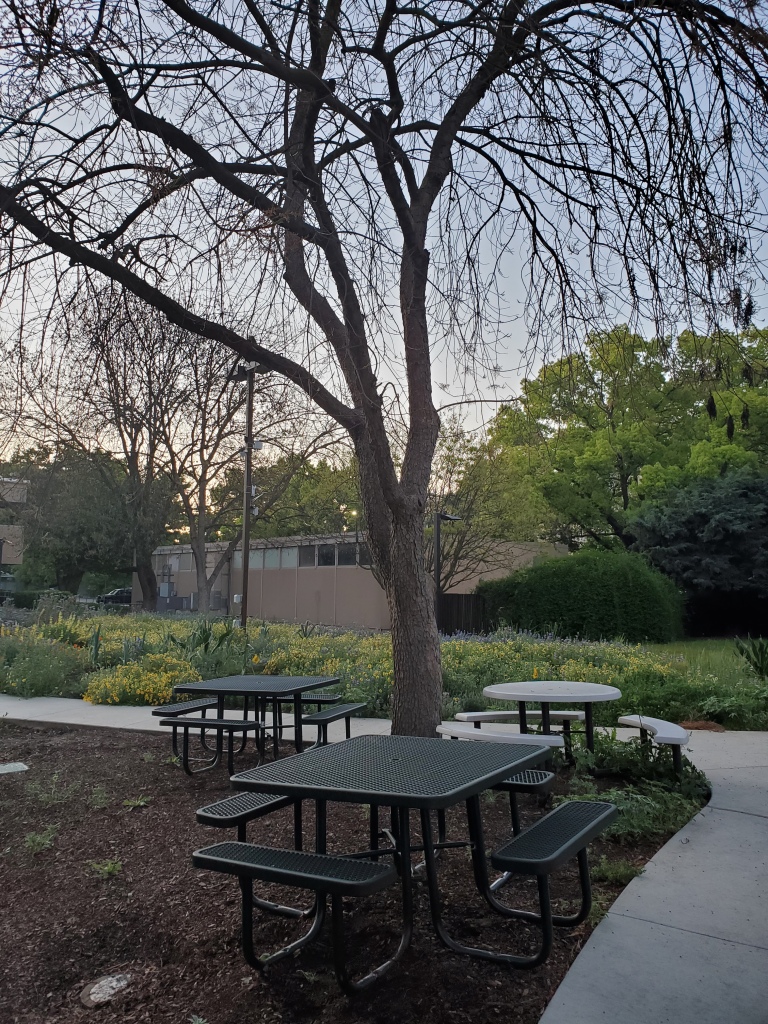
I have spent much time at the BOG. Previous iterations of Wild Davis have used it for a pollinator activity and several of my faculty colleagues and I meet regularly at the BOG picnic benches to share lunch. Consequently, it is a place I associate not only with natural beauty, but also with friendship. This quarter, isolated in my house with only my husband and my cat, teaching both of my courses online, and sequestered from nearly all normal human interaction, I chose to visit the BOG in the hopes of channeling the camaraderie I have felt there previously.
I arrive at the BOG at 6:15 am on Friday April 10th. Other than a couple trips to the grocery store and a few afternoon walks around my neighborhood, this is the only time I’ve left my house in… two weeks? Two and a half? It’s hard to gauge the passage of time these days. Traffic (both vehicular and pedestrian) on my way to campus was sparse. As an early riser, I know this time of day is generally sparse in human activity, but today it reminds me of how empty the streets always are now.

When I arrive at the BOG, it is not surprisingly entirely empty, though I can hear grounds crews working somewhere to the north, including the back-up beep of a large vehicle. There have always been a few mismatched picnic tables scattered about the BOG grounds, but near the end of winter quarter, they completed a small sitting area in the center of the BOG, complete with three new picnic tables under a large tree. I choose the middle table and spread out my notebook, camera, and thermos of coffee to begin my observation.
lt is chilly this morning; cool enough that I can see my breath when I exhale, and that sitting on a metal picnic bench is uncomfortable, but not so cold that my thermos of coffee can’t keep me warm. I sit quietly for a moment at the bench, noting what birds I hear. I note an occasional crow caw and a handful of songbird, one of which is the house finch, though the others I am not confident I can identify. I take several pictures of them to hopefully identify later, but my angle is strange (directly beneath the birds high in the tree) and the grayness of early morning light washes out much of their color. The bright yellow one with the black capped head is an American goldfinch, and I think I also see a yellow rumped warbler, though I’m not certain. When I return from my observation, I will look up both birds calls in the Cornell Lab to see if I recognize them as any of the other bird calls I hear this morning (spoiler alert: I don’t recognize them).
As I’m noting these in my journal, I hear the unmistakable caw of a raptor, and barely catch in my peripheral vision a medium-sized bird landing in the tree behind me. I keep an eye on the bird, noting that it is clearly eating something it holds in its talons. I take a few pictures with my camera, which come out absolutely hideous in the low shadowy light of the early morning. I can’t seem to get a clear view of it with the camera or my eyes and am not certain what kind of bird it is. It seems too small to be an adult red-tailed hawk, but too large to be a kestrel. The pale orange-y banding on its chest suggests a red-shouldered hawk, though it seems small for a hawk. Perhaps it is a juvenile. I try unsuccessfully for a better photo until it takes it’s meal elsewhere.
The hawk reminds me of a hawk I have seen and heard around my own apartment recently in north Davis. Nearly every afternoon, I have heard its raucous caws and it has occasionally been accompanied by one or two other hawks. I have also seen it twice around the corner from my apartment when I go for a walk – both times it carried a kill to the top of the same tree. I wonder if it is nesting there, though I haven’t been able to see a nest, despite bringing binoculars. The new hawks in my life remind me of a book I recently read, Red Tails in Love, about the trials and travails of mating hawks in New York City’s Central Park and the birders who documented their lives. It is a sweet story, and I wouldn’t mind following these hawks’ lives much as the Central Park birders did.
The BOG is still under development, which means it looks a little different every time I come. As I wander the gardens today, I notice several new components. First, in the garden behind the picnic benches, several plants are bagged and tagged with different colored tape. Bagging is a common practice in research on flower pollination, so that the researcher can control what pollinators have access to the flowers. I also notice what appears to be a weather data logger posted to one of the light poles. These both indicate that the garden is being used for active research and I make a note to ask one of the BOG’s organizers, Ernesto Sandoval, about this. If there are interesting data coming out of the BOG, we may be able to utilize it or contribute to it as part of the class. Next year, anyway…
I also notice a new artistic component. One of the trees has a mirror anchored in the scar of a pruned limb, and below the mirror hangs a tag that reads “Thank the tree for the air you breathe.” I am unsure about the purpose of the mirror (I have seen one on another tree on campus, near the Student Community Center and it equally confused me), though the tag is not wrong in its emphasis on trees’ contributions to atmospheric composition. I pat the tree on the trunk and thank it.

In our guidance on the activity, TA Chris Jadallah and I emphasized to the students to consider all their senses. I have not yet tried smell, so I focus on this sense for a moment. Even this early in the morning, without the heat of the sun to warm them, I can smell a sweet scent of flowers. It is strongest near the patch of Phacelia and lupine, though when I smell each individually, they do not seem to match the scent. Perhaps it is a bouquet of all the contributions, or perhaps it is the apple trees, which are too far from the sidewalk for my nose to reach directly.
When I have been here during the day, I have very much enjoyed the plethora of pollinator activity in the BOG. In the best times, with warm weather and at the height of flower maturity, they make an audible buzz and the air above the flowers seems to shimmer with their activity. I see only one pollinator this morning, and it is in the last minute or two of my observation. I find a single bumblebee on the Pride of Madeira flowers that are technically landscaping around Hoagland Hall and not formally part of the BOG.
The bumble reminds me that I had been intending to document the flowering plants in the BOG on iNaturalist, for possible pollinator associations in the future. I also am trying out new citizen science projects, so I use the new Seek app through iNaturalist to document a few species. I also plan to make the BOG a ‘place’ in iNaturalist, which will allow me to track organisms documented there more easily. Over my mid-day observation in a few weeks, I can do a more formal survey of the plants present and their pollinators.
As I’m leaving the BOG, I note two more things that I have never seen here before. The first is a small lawn, at the back of which are two benches tucked under the shade of a tree. I’ll have to remember this location for the times I need a quiet space to escape to outside of my office. The second is a memorial posted in front of one of the trees on the edge of the BOG. I do not know who Harry Gee is, or what relationship he had with UC Davis in his 30 years of life. Still, I respect this type of memorial. I have already donated my body to research when I die, which means I will have no cemetery plot or headstone. My mother once asked where she should go, then to mourn me, and I like the idea of a living ‘headstone’ as a place of remembrance.

This activity has been bittersweet. Normally, I love the solitude and time dedicated for quiet reflection. This spring, though, I’m having more solitude than I care for and the things I have to quietly reflect on are mostly just depressing. I hope the students have enjoyed a chance to get outside and stop watching lecture videos for at least a few minutes, and I look forward to hearing in class this week what they observed.
2019 Popsugar Reading Challenge Complete!
There are few things in life that Laci loves more than books and lists (and completing things well ahead of schedule), so you can imagine my excitement when I discovered the 2019 Popsugar Reading Challenge. The Challenge has been around for five years now, but I’m just now joining the club.
The really awesome thing about the Challenge is that the reading list is not a list of books, it’s a list of prompts for which a wide variety of books could be selected. To help you choose, there’s a Goodreads Group with over 23,000 members contributing to discussion boards relating to each prompt. It’s a fantastic way to branch into new genres, or play it safer with your old favorites.
The Challenge has two parts, the ‘regular’ list of 40 prompts, and an ‘advanced’ list with 10 additional prompts that are a little more difficult or specific. Being an overachiever and an avid reader, I of course did the full 50. Here, I’ll list out what I picked and link to each book’s Goodreads page for descriptions and reader reviews. You can also see my ratings for each book on my Popsugar Shelf and see how I’m progressing on my 2019 reading goal of 100 books.
The Regular List

- A book becoming a movie in 2019
Good Omens by Terri Pratchett and Neil Gaiman - A book that makes you nostalgic
The Phantom Tollbooth by Norton Juster - A book written by a musician
The Rose That Grew From Concrete by Tupac Shakur - A book you think should be turned into a movie
Seafire by Natalie Parker - A book with at least one million ratings on Goodreads
The Kite Runner by Khaled Hosseini - A book with a plant in the title or on the cover
Nature’s Temples by Joan Maloof - A reread of your favorite book
Animal Dreams by Barbara Kingsolver - A book about a hobby
The Feather Thief by Kirk Wallace Johnson - A book you meant to read in 2018
It was hard to pick just one, but I went with the 2018/19 UC Davis Community Book Project choice The Book of Joy by the Dalai Lama and Desmond Tutu - A book with ‘pop’, ‘sugar’, or ‘challenge’ in the title
Sugar by Bernice McFadden

- A book with an item of clothing or accessory on the cover
Queens of Innis Lear by Tessa Gratton. The best accessory is a crown, for sure - A book inspired by mythology, legend, or folklore
The Gods of New Asgard Series by Tessa Gratton - A book published posthumously
I’ll be Gone in the Dark by Michelle McNamara - A book you see someone reading on TV or in a movie
The Shining by Stephen King, which Joey and Rachel read on Friends and Joey finds so scary that he hides the book in the freezer - A retelling of a classic
When She Woke by Hilary Jordan - A book with a question in the title
Where’d You Go, Bernadette by Maria Semple - A book set on a college or university campus
Lucky by Alice Sebold, a memoir of her college sexual assault experience - A book about someone with a super power
Who Fears Death by Nnedi Okorafor - A book told from multiple character POVs
The Machine’s Child by Kage Baker - A book set in space
Look to Windward by Iain M Banks
Both Natalie Parker and Tessa Gratton are close friends of mine, and I had gotten shamefully behind on their latest books – the Challenge gave me the perfect excuse to catch up!

- A book by two female authors
The Wife Between Us by Greer Hendricks and Sarah Pekkanen - A book with a title that contains ‘salty’, ‘sweet’, ‘bitter’, or ‘spicy’
This Bitter Earth by Bernice McFadden - A book set in Scandinavia
The Core of the Sun by Johanna Sinisalo - A book that takes place in a single day
The Regulators by Richard Bachman (aka Stephen King) - A debut novel
The End We Start From by Megan Hunter - A book that’s published in 2019
Tiamat’s Wrath by Ian Cormac - A book featuring an extinct or imaginary creature
Song of the Dodo by David Quammen - A book recommended by a celebrity you admire
Becoming by Michelle Obama - A book with ‘love’ in the title
Love in the Time of Cholera by Gabriel García Márquez - A book featuring an amateur detective
Sleeping Murder by Agatha Christie
I chose several books from Lit Hub’s 30 Dystopian Novels By and About Women list, including The Core of the Sun, which begins “I lift my skirt, pull aside the waistband of my underpants, and push my index finger in to test the sample.”
Now that’s an opening line.

- A book about family
The Home Place by J. Drew Lanham - A book written by an author from Asia, Africa, or South America
Unbowed by Wangari Maathai - A book with a zodiac sign or astrology term in the title
The Pisces by Melissa Broder - A book that includes a wedding
Our Kind of Cruelty by Araminta Hall - A book by an author whose first and last names start with the same letter
Circe by Madeline Miller - A ghost story
Beloved by Toni Morrison - A book with a two-word title
Find Me by Laura van den Berg - A novel based on a true story
The Girl Next Door by Willow Rose (based on the BTK Killer) - A book revolving around a puzzle or game
The Rule of Four by Ian Caldwell - Your favorite prompt from a past Popsugar Reading Challenge
There were SO MANY good options, but in the end I chose “A book you got from a used book sale” from the 2017 Challenge. For which I read The Fifth Season by NK Jemison

For Black History Month in February, I decided to read only books by African or African American authors. Not all of them counted for the Popsugar Challenge; they included
- 12 Years a Slave by Solomon Northrup
- The Sugar Lacey series by Bernice McFadden
- Dreams From My Father by Barack Obama
- Unbowed by Wangari Maathai
- Beloved by Toni Morrison
- The Hate U Give by Angie Thomas
- The Fifth Season by NK Jemison
- The Home Place by J. Drew Lanham
- Who Fears Death by Nnedi Okorafor
The Advanced List

- A climate fiction book
The MaddAddam Series by Margaret Atwood - A choose-your-own-adventure book
Neil Patrick Harris’ Choose your Own Biography by NPH - An ‘own voices’ book
The Hate U Give by Angie Thomas - Read a book during the season in which it is set
Early Riser by Jasper Fforde (read in winter) - A LitRPG book
Warcross by Marie Lu - A book with no chapters, unusual chapter headings, or unconventionally numbered chapters
Cujo by Stephen King (no chapters) - Two books that share the same title
The Salt Line by Elizabeth Spencer and The Salt Line by Holly Goddard Jones - A book that has inspired a common phrase or idiom
The Stepford Wives by Ira Levin - A book set in an abbey, cloister, monastery, vicarage, or convent
The Murder at the Vicarage by Agatha Christie
Overall, I really enjoyed the Challenge – it got me to read some things I’d been meaning to get around to for a long time (Agatha Christie, Gabriel García Márquez, etc) and some things I probably never would have considered reading (Tupac’s poetry). I’m already looking forward to next year’s prompts!
Wild Davis Observations: East Regional Pond at Dusk
As we near the end of the quarter, my Wild Davis students are completing their final timed observations. At the start of the quarter, they chose an urban location to sit at for 45 minutes at dawn, and later at mid-day. This week, they went to the same location for 45 minutes around dusk. For my observations, I’ve been visiting the East Regional Pond in Woodland, just north of Davis.

After the mid-day observation, I made the Pond a formal Place in iNaturalist so I could easily track what wildlife has been found there. Consequently, I arrive at the Pond about 7:30 on Monday evening with a couple goals: 1) bypass Greg Ira (Cal Nat program coordinator) as the top observer at the pond and 2) observe a river otter, which have been documented in the Pond by both Greg and iNat user natewl. I casually inquired with some colleagues and Greg is totally unaware of our ‘competition’ at the Pond, which makes meeting Goal 1 more likely. Both of the otter observations already posted were made around dusk in the spring, which makes Goal 2 seem likely, though I am well aware of how elusive otters can be.
When I arrive at the Pond, I follow the same pattern I have on the other observations, starting at the east-facing deck with the plan to rotate between the three observation decks throughout the observation. In my past visits, the north-facing deck has the most activity, so I intend to spend the bulk of my observation there. The first thing I notice from the east-facing deck is that the water level is higher than it has been in my previous visits – the central ‘island’ is nearly submerged in water, and only a small rise of muddy sand rises above the water level.
I am absolutely ecstatic that there are no Canada geese and so, though the beginning of my observations is full of bird song, particularly an amorous cacophony from the male grackles chasing after the two ladies, there is not a single sonorous nasal honk to be heard. That is, until about 8:15 when the entire family comes swimming home from wherever. They are as annoyingly loud as ever, but do make an adorable little train on their way in. I enjoy how you can tell even from a distance the adults, the juveniles, and the little chicks. I notice the chicks are up front, protected on either end by adults, and the juveniles come next with an adult in the middle and one bringing up the rear. I wonder if this order is intentional, to protect and guide the young geese.

My previous observations had been curiously devoid of humans. The Pond is near to town, beautiful and calming, and full of good bird observing, which made me surprised that there were not other people here taking a relaxing turn around the observation decks. When I first arrive this time, a young man is skateboarding along the trail away from the east-facing deck and I don’t pay enough to attention to notice where he goes; that is, until I make my way to the north-facing deck and find him seated on his skateboard with headphones in, watching the water. I consider leaving, but the north-facing deck has the best views, and the deck is certainly large enough for two people to look out and not overtly bother one another. I worry I’ll startle him if he’s playing music through his headphones, so I make a point to come around into his view as far to the side as possible so as not to creep up on him. I start to say hello and realize he is sobbing quietly to himself and I feel instantly awful for disturbing him. I apologize for the disruption and ask if he’s ok, which is stupid since he is obviously not ok. He hesitates, then nods awkwardly, and I leave awkwardly.
On my way back from the north-facing deck, I notice two kittens, scurrying under the chain-link fence that surrounds the Pond. They are in the exact same location in which I saw an adult cat on my mid-day observation and I’m not exactly pleased that the stray cat has reproduced. Feral cats are incredibly destructive, especially to wild birds and an increasing population of cats here is not promising for the birds’ safety.

When I make it back around to the east-facing desk, there are two cars in the lot (in addition to my Jeep) and two teenage women walking down the path with a pre-teen boy gamboling after them. I continue on to the south-facing deck, where I can just see them stumble upon the young man as I did and also awkwardly return to the east-facing deck. I feel even worse for the poor guy, being repeatedly interrupted when he clearly came here for solitude.
The south-facing deck has been the least interesting on my previous visits and tonight is no different; with one exception – while scanning through my camera, using the long lens like binoculars, I notice a napping duck tucked away in the foliage of little island in the middle of the pond. I snap some photos and confirm later that it is a cinnamon teal! I had very much wanted to find one of these, since they are beautiful and one of the species that Greg had found that I had not 🙂

I make my way back to the east-facing deck for the last 15 minutes of my observation. I am keeping an eye out for otters, when the whole Pond goes silent just for a moment. There must be a gap in the traffic because I didn’t even notice I could hear the cars on Road 102 behind me until they now pause. The numerous birds all also pause for just a moment in their song, and all I hear is the soft sound of the light breeze over the water. It is a calming moment, and beautiful, and I wonder if it was entirely by chance, or if the birds all sensed something that I didn’t.
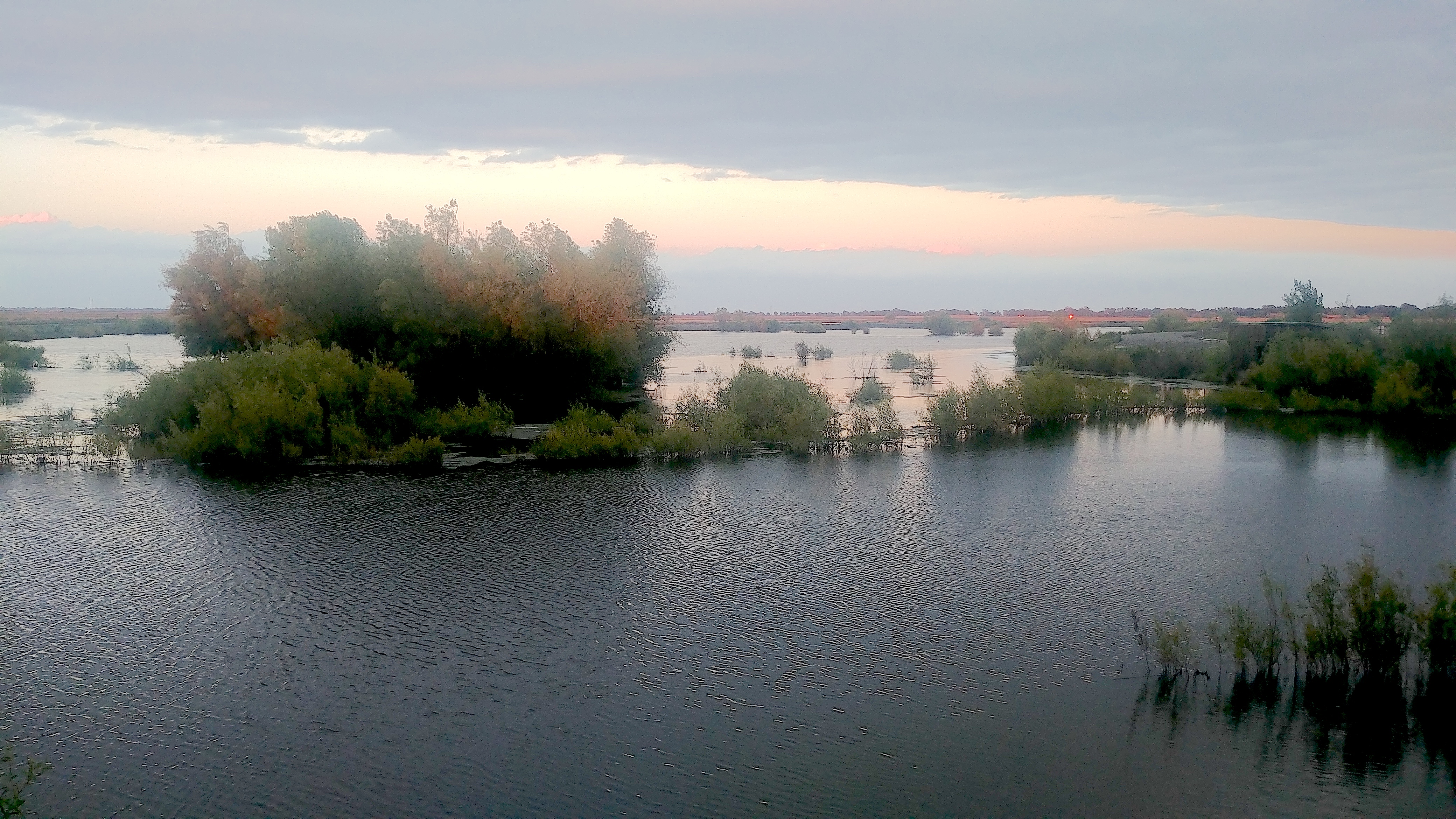
After posting my observations to iNaturalist when I get back, I review my goals. Goal 2 is a wash – I found no otters, though I will keep an eye out if I find myself in that area around dusk again. Goal 1 is met in letter, if not in spirit. I managed to tie Greg with 58 observations at the Pond; however, EVE professor Jonathan Eisen has ousted both of us with 63 observations! Jonathan was the top contributor to the Sacramento Region City Nature Challenge and since then has gotten really into iNat and has been uploading a large number of photos from previous wildlife-viewing trips. Consequently, many of his observations are newly posted, but not newly taken – he’s been ahead of Greg and I for some time, we just didn’t know it! Amusingly, I am also tied for second place in number of species identified. I am still 7 species behind Greg and tied with Jonathan at 27 species.
My time at the Pond is technically over, though I would like to continue visiting. It is an odd place, simultaneously serving municipal needs (stormwater drainage), ecological needs (waterfowl habitat), and social needs (privacy and seclusion for Woodland residents). It feels more isolated and ‘wild’ than it truly is, which is perhaps why both the birds and the teenagers enjoy it so. I will have to keep an eye out, still, for otters, and hope to pass Greg and Jonathan in observations and species numbers in the near future 🙂




